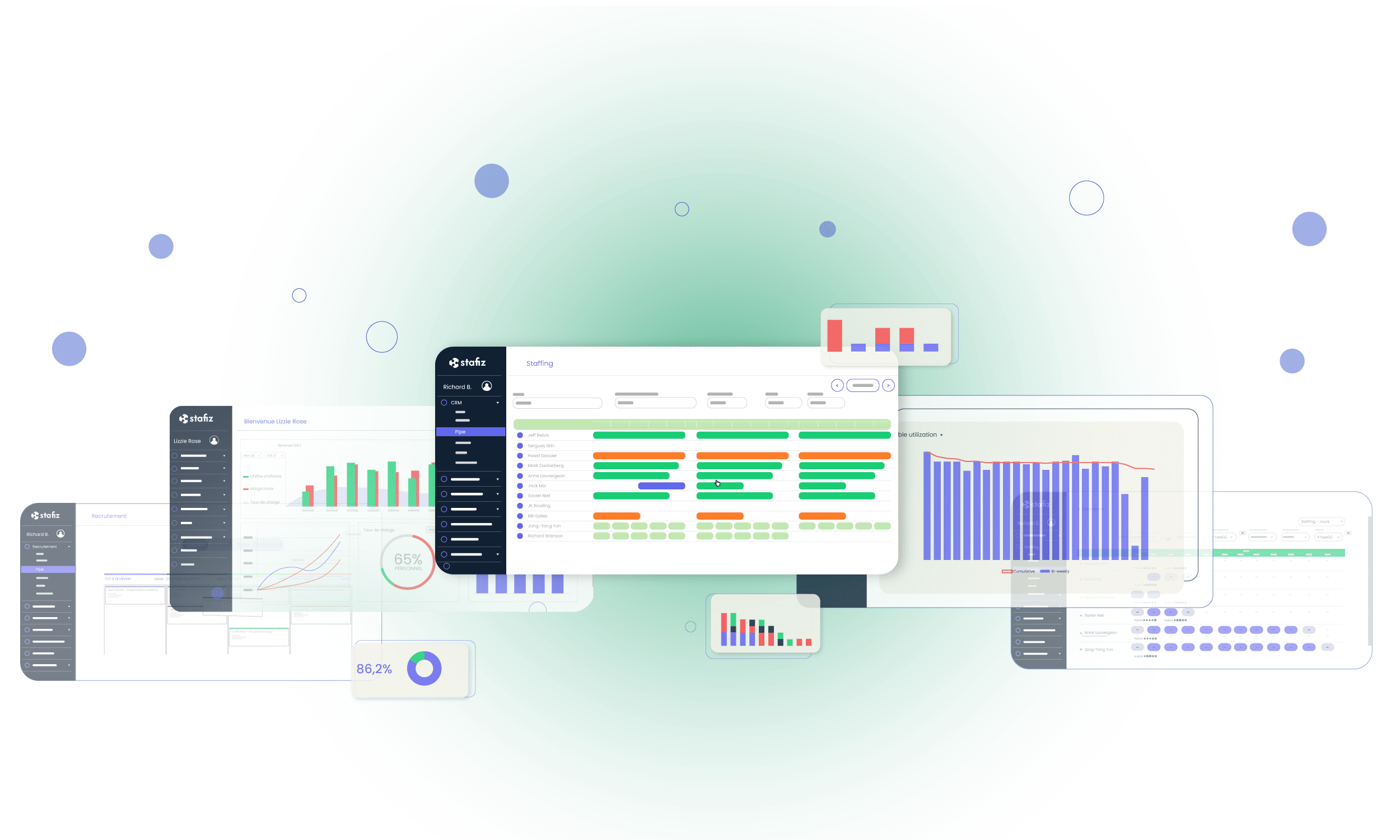Guide: 5 Steps Towards an Effective Resource Management

Managing project resources can be a complex task, especially in large companies or those working on several projects at the same time.
However, by following a series of steps and with the support of certain technological solutions, it is possible to achieve a truly effective resource management in an agile and organized way.
What is Resource Management?
Resource management is a process that includes inventorying, analyzing, planning, coordinating, using, and tracking all the tools and elements available to complete a project.
The main objective of resource management is to obtain an overview of all the tools, equipments and employees in order to plan the execution of a project in the most cost-effective manner and in the shortest possible time.
Why is Managing Resources Important?
Good resource management is essential to ensure the viability of a project.
It includes setting objectives, planning on the basis of the budget, checking the availability of resources and monitoring them.
It must be based on three key values: efficiency, sustainability and cost reduction.
- Efficiency: use as few resources as possible to achieve maximum performance through an optimized time management.
- Sustainability: a sustainable management avoids limiting resources and allows them to perform at their best without overloading or overworking the project.
- Cost reduction: maximize return on investment by reducing costs as far as possible without jeopardizing the project, while respecting deadlines and objectives.
What Different Types of Resources Can Be Allocated to Projects?
Numerous resources may be required to complete a project. The main types include :
- material and technical resources management: these are the tools, components, licenses, equipment, machines and premises that will have to be physically used to achieve the project's objectives.
- human resources (or HR): this concerns the employees you'll need. It also includes employees management in the broadest sense, such as training, availability, skills and competencies, as well as performance.
- Financial resources: the budgets needed to carry out the project. They include bank loans, liquidity, alternative sources of financing, investments and expected returns, etc.
Who is Responsible for Resource Management?
Different job profiles can be responsible for resource management.
Usually, the project manager is the main person in charge. But at the same level, or higher - depending on the company's hierarchy- the CFO or HR Director may be in charge.
Depending on the size of the project, the resource manager can also be the department head, a manager, or a senior executive.
Resource optimization and management go through five key steps:
-
- Setting goals
- Budget planning
- Resource Capacity planning
- Allocation of available labour
- Project monitoring
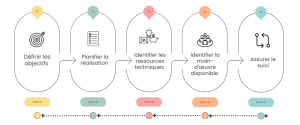
Step 1: Define the Project's Goals
The first step in resource management is to clearly define the objectives, whether they are time, financial or otherwise.
Not knowing how much time you have to complete a project makes it difficult to determine how many resources you'll need to bring it to fruition.
Let's take the example of a consulting agency that needs to carry out market research on worker motivation in Spain. The first step is to answer the following questions:
- When do I have to submit the report?
- In what format? Online only or in physical format as well?
- Is the objective to present the results to the public or to sell them privately to companies likely to be interested in such an analysis?
These responses will determine the objectives to which resources should be allocated.
Step 2: Plan and Budget the Project Accordingly
Once you've set the objectives, turn the details of the project into a roadmap to prepare its execution.
Now is the time for strategic planning, establishing the project tasks to be carried out and organizing them on the project schedule.
Based on this information, you create a provisional budget that will take into account:
- technical resources costs (materials, services, software) that will be required;
- human resources costs such as salaries and expenses, depends on their professional profile and the key skills required to successfully complete the project;
- financial costs (provisions, credits, etc.).
Let's take the example of market research again.
Consider that the consulting firm intends to unveil its study publicly at a press conference on May 25. It decides to provide the results of the survey in both physical and digital form.
This is the definition of the project. The planning associated with this project could be as follows.
- From 1 to 15 April: a survey of employees is conducted.
- April 15 to 30: Preparation of a report based on the results obtained.
- May 1 to 15: Design of the report online and on paper.
- From 1 to 20 May: organisation of the press conference and its presentation.
Each of these tasks can include other subtasks, for example:
- Event Organization
- Finding a venue for the event
- Training of spokespersons to present the study
- Calling media and customers (visual design of the invitation, sending emails to potential guests, promoting the event on social media)
- Organisation and conclusion of a catering contract
- Lighting and sound system organization
Each planning stage must be associated with costs that must be taken into account when planning and controlling the budget.
It will be necessary to estimate, for example, how many hours it will take to reserve a space for the press conference (calls, visits, etc.), but also what the hourly cost of the person who will carry out this task is.
Step 3: Identify the Resources Needed
All the needs and tasks associated with the project require adapted resources.
This process of identifying the requirements for the project (the demand) and aligning them with the resources needed to meet the project objectives (the supply) is known as resource capacity planning.
Resource Offer
Adequacy is based on the criteria of skills, availability and motivation of people.
Additional complexity arises when an organization manages multiple projects in parallel. It will then be a question of planning this approach by intelligently distributing human resources.
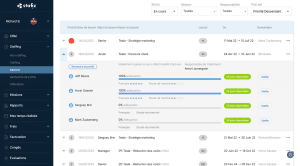
Resource Demand
On the demand side of resources, i.e. on the needs side, there are several levels of criteria to be taken into account.
In the short term, as close as possible to the field, the pipe – in other words, the projects or assignments that are most likely to be won – will determine the needs in terms of profiles.
In the medium and long term, it is the market and the company's strategy that will determine the needs of profiles. What will be the needs of customers in the future? What skills will be sought? What positioning and needs will the company seek to satisfy?
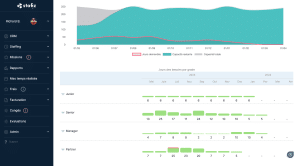
Stafiz integrates key resource capacity planning features for service companies: multi-criteria search for internal or external profiles, demand management and degrees of suitability.
Step 4: Allocate Resources to Projects
The allocation of human resources in project management corresponds to knowing exactly the staff available and coordinating the actions to be carried out by each of them.
This management involves a detailed assessment of the resources available, which is based on three key points.
Resource Availability
Ensure the availability of resources to staff to avoid friction on schedules. This is especially important in companies that have multiple projects in the works.
Learn more about resource availability
You may have a design team that can be responsible for the layout of the report. But do they really have the time to take care of a new project or will they have to outsource this function to be on time?
Capacity planning
Before you assign a resource to a task, make sure that he or she has the skills to complete it.
Keeping the example of the consulting firm, it was decided that the design would be done both physically and on paper. Do designers have the skills required to produce in both formats?
The Mission's Appeal to Employees
It's important to assess your teams' motivation regarding the missions they are working on.
How will the employees who will be involved in the project feel? It is worthwhile to carry out a previous performance evaluation, which can be used to set new milestones in the employee's professional plan.
It is also important to know whether the employee is actually ready and motivated to take on this new challenge.
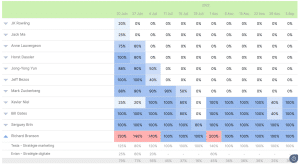
With all this information, and once you've gone through the previous steps, you can start drawing up the workload plan and calculating it. To allocate tasks, use a resource management tool or a GANTT chart.
To maintain a balanced workload, track resources using dashboards.
Digitalize and simplify employee scheduling & workload management
See Stafiz in action in 2 minutes
Step 5: Project Monitoring
You still have to follow the resources and the progress of the project in order to corroborate the smooth running of the project, bothfrom an economic point of view and from an HR point of view.
These two factors are essential for the project to achieve its objectives in practice.
Financial Monitoring
The first thing to do for the accounting monitoring of the project is to establish the billing method of the project. The main methodologies are as follows:
- Invoice the customer on delivery complete project project.
- Establish time milestones or other types of timelines to bill the project based on planned accomplishments.
- Invoice by time spent.
To learn more about billing, check out our complete file on billing for service companies.
The methodology chosen will guide your approach to financial monitoring.
In the first case, proactively monitor expenses against the work done to determine if the project is on the right trajectory.
If you detect inconsistencies, take corrective actions such as value for money, cost reduction, or other measures that meet expected profitability.
In the case of step-by-step or hourly billing, the methodology is the same. The only difference is that it will be mandatory to do this tracking to receive payments.
If we delay this follow-up, we delay obtaining liquidity. In any case, project control software makes this financial monitoring and decision-making task much easier, with very useful features such as:
- financial readjustments and reorganization of tasks in a fast and agile way;
- time entry and management ;
- Access to information on project costs, cost sources and profitability in real time.
The last step in properly tracking financial resources is to correctly calculate the profitability or margin that the project leaves us.
Again, project management software provides real-time data on costs and invoicing. This allows us to quickly detect whether, in fact, margins are in line with expectations. And, if not, to highlight the elements that hinder it.
Employee Monitoring and Management
Especially in projects billed by the hour, it is essential to know the actual performance of the professionals.
In other words, how much of the work they do on a day-to-day basis that is actually billable to the client.
To find out, it is necessary to Calculate utilization rate. This is the percentage of time an employee spends on billable projects versus non-billable projects.
Now let's imagine that the report in the previous example is not public. This is a job commissioned for another consulting company that will pay us to have exclusive access to the information we provide. In this case, it is a billable project.
If a designer in the marketing department spends 5 hours per day this week on the layout and design of this report, their workload rate is 71.42%. Five billable hours, compared to two non-billable hours, as part of their working day, or seven hours per day in total.
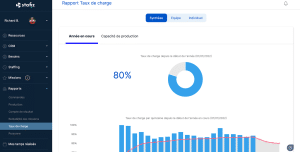
This data is very important for project tracking, as it allows teams and workloads to be reorganized in real-time, without losing sight of profitability per worker, their costs, and the value of the time they invest in their daily work.
Questions:
The main goal of resource management is to get an overview of all tools, equipment, and personnel, in order to plan the execution of a project in the most cost-effective way and in the shortest possible time.
Different job profiles can be responsible for resource management. Typically, the project manager is the main culprit. But at the same level, or at a higher level depending on the hierarchy of the company, we also have the CFO or the HR director.
Depending on the size of the project, the resource manager can also be the department head, a manager, or a senior executive.
- Plan accurately: Anticipate resource needs based on upcoming projects and business opportunities.
- Use the right tools: Does your resource management software give you enough real-time visibility? Forecast?
- Communicate effectively: Ensure smooth communication between teams to avoid conflicts between teams resource planning.
- Analyze data: Meticulously track your previously defined KPIs based on your goals.
- Be flexible: adapt the project schedule and resource allocation according to the unexpected.
Effective management of the resource planning Helps increase productivity by ensuring the right people are working on the right tasks at the right time.
This reduces resource costs, among other things, and thus increases profitability. In addition, it ensures a better quality of delivery, leading to greater customer satisfaction.


